Perf Increase!
- Details
- Written by Kevin Horton
- Hits: 4518
I didn’t get flying last weekend, due to terrible weather. I did get the landing light bulb replaced on Sunday - I had noticed some time ago that it wasn’t working. I don’t plan to do any night flying, so I don’t need it as a landing light, but it and the taxi light can be selected to flash alternately, which makes it much easier for other pilots to spot this small aircraft. The flasher system won’t work if only one of those lights is operative, so I was keen to get the burned out bulb replaced.
Today I took advantage of the good weather to do some performance testing. I had noted since I started flying in November with the rebuilt engine, that the indicated airspeeds for any given power setting seemed to be several knots faster than I was seeing before. On the one hand, I was happy to see the aircraft apparently performing better, on the other hand I was suspicious of these speeds. Could there be some new error in the airspeed system?
Today I took a few minutes and did a four sided box pattern at 160 kt IAS, hand recording the data needed to check the accuracy of the indicated airspeed. I found that the airspeed was still fairly accurate. In the distant past, before the aircraft was painted, I found that there the indicated airspeed was about 1 kt too high in this speed range. After the aircraft was painted, the error seemed to have changed by roughly 1 kt, so it was approximately correct in this speed range. Today, I found that the indicated airspeed at 160 kt was about one kt too low. The test wasn’t of perfect quality, but the result should be good to plus or minus 1 kt.
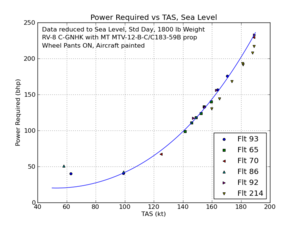 Next, I gathered some cruise speed vs power data. Assuming the airspeed errors were unchanged from my original testing, the speeds I got today were about 5 kt faster for a given power than they were in the distant past. If the airspeed system errors have changed by two kt, as today’s single test point might suggest, then the speeds I got today were about 7 kt faster than before. Great!
Next, I gathered some cruise speed vs power data. Assuming the airspeed errors were unchanged from my original testing, the speeds I got today were about 5 kt faster for a given power than they were in the distant past. If the airspeed system errors have changed by two kt, as today’s single test point might suggest, then the speeds I got today were about 7 kt faster than before. Great!
Today’s data is Flt 214. The blue line is the average of all the earlier data.
I had always been somewhat suspicious of the engine power since it came back from the big overspeed event on flight 13. I wonder if perhaps something was not right with the engine all this time. Now the speeds I am getting are much more in line with what I would have expected.
Update - 06 May 2013 - I discovered a very stupid error when I did the data analysis from this flight. I failed to convert the hand recorded Outside Air Temperatures from deg F to deg C. I reran the analysis after correcting this error, and now it shows the hand recorded results from Flight 214 were about 2–3 kt faster than the laptop recorded data from 2010. I finally got my data recording system working again, and I plan to record cruise performance data on several flights over the summer.
Annual Inspection
- Details
- Written by Kevin Horton
- Hits: 2306
Terry was out of town for a week, and the aircraft was coming due for its annual inspection, and it was warmer than usual on Sunday, so I spent the day at the hangar. I got a bunch more done on Monday, when it was still warmish, but it was darned cold finishing things up Tuesday AM. No big issues found, fortunately.
iPad Mini Trial
- Details
- Written by Kevin Horton
- Hits: 2822
I got an iPad Mini for Christmas, and the hardware needed to mount it in the aircraft arrived this week, so today I finally tried it out in the aircraft.
 A RAM X-Grip II holds the iPad Mini firmly in its spring loaded grip.
A RAM X-Grip II holds the iPad Mini firmly in its spring loaded grip.
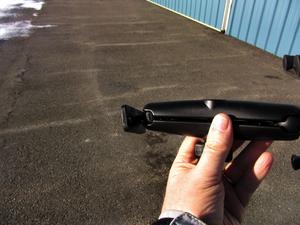 I bolted a 1" ball to the left side of the cockpit and a 6" arm connects the ball and X-Grip together.
I bolted a 1" ball to the left side of the cockpit and a 6" arm connects the ball and X-Grip together.
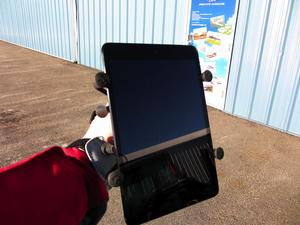 This shot of the iPad in the mount also hints strongly at potential glare.
This shot of the iPad in the mount also hints strongly at potential glare.
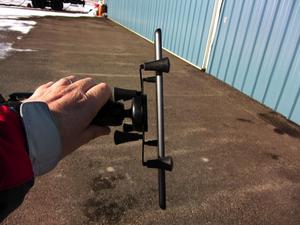 The soft rubber tips on the X-Grip arms firmly grip the sides of the iPad.
The soft rubber tips on the X-Grip arms firmly grip the sides of the iPad.
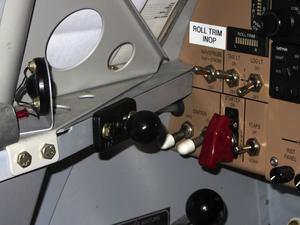 The 1" ball is mounted high on the left side of the cockpit.
The 1" ball is mounted high on the left side of the cockpit.
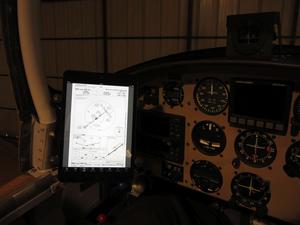 One potential mounting position, trialed in the hangar. This one put the iPad Mini in a good viewing location, but partially hindered access to the knobs on the left side of the Garmin GNS–430.
One potential mounting position, trialed in the hangar. This one put the iPad Mini in a good viewing location, but partially hindered access to the knobs on the left side of the Garmin GNS–430.
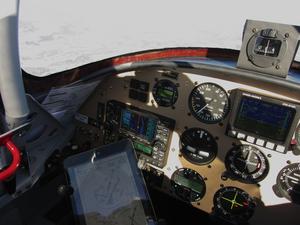 Today looked to the best weather day for the next little while, so I took a day off and went flying to try out the iPad Mini airborne. I ripped down to Kingston to do an NDB approach, then over to Brockville and then back to Smiths Falls. The 116 nm triangle took 1:02 airborne, including a full procedure instrument approach at Kingston, two touch and go landings at Kingston and one at Brockville.
Today looked to the best weather day for the next little while, so I took a day off and went flying to try out the iPad Mini airborne. I ripped down to Kingston to do an NDB approach, then over to Brockville and then back to Smiths Falls. The 116 nm triangle took 1:02 airborne, including a full procedure instrument approach at Kingston, two touch and go landings at Kingston and one at Brockville.
This lower location provides better access to the GNS–430.
I concluded that the iPad Mini is a definite improvement over the full size first generation iPad I was using, on a kneeboard. But, I don’t have the perfect setup yet. The long arm between the ball and X-Grip allows quite a range of locations, but the angle of the ball isn’t ideal. Some desired iPad locations simply aren’t possible with the current angle of the ball, as the arm jams up against the stud that joins the ball to the base. I may need to come up with a way to mount the ball so it is angled aft, to better align with the arm. I also need to add an anti-glare screen protector.
No RV Flying This Week
- Details
- Written by Kevin Horton
- Hits: 2409
No flying this week end, due to terrible weather. We’ve had quite a thaw over the last few days, and the moisture from the melting snow lead to persistent low ceilings. I did manage to get two proficiency flights in on Transport Canada aircraft last week, and I’m supposed to fly two people to Quebec City tomorrow morning, so I won’t complain about not flying.
I took advantage of the warm weather to scrape the accumulated ice off the paved area in front of the hangar. There were several ice ridges caused by vehicles turning around in front of the hangar, and packing down any snow that was under the tires. Those ridges were a bit of a pain when rolling the aircraft out of the hangar, as you needed to build up some speed so it would make it over the bumps.
Range Rings
- Details
- Written by Kevin Horton
- Hits: 2707
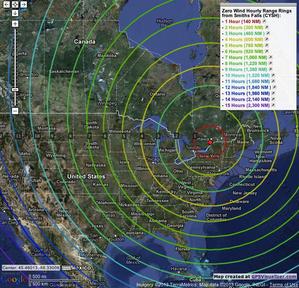
I stumbled across a GPS Visualizer tool that allows you to do things like create images with range rings. I created a page with range rings from Smiths Falls airport, showing how long it would take to get to various places, assuming no wind. My normal cruise speed is 160, but you don’t get that far in the first hour, as the airspeed is slower as you climb to altitude, and it takes a few minutes at the other end to do the traffic pattern and land. I assumed 140 nm for the first hour. The next two hours are 160 nm further for each hour, as the whole additional hour is spent at normal cruise speed. After three hours, I assume I would land for a pit stop, so the fourth hour is back to 140 nm, etc. I could fly four hour legs, but I wouldn’t enjoy the last hour at all, if you know what I mean.
The GPS Visualizer will create an interactive page, which can be zoomed and panned, background maps can be changed, etc., but there was no way to embed the interactive page directly in this site. You’ll find the interactive range ring page at:
Two Flights
- Details
- Written by Kevin Horton
- Hits: 2638
We had another good weather day on Saturday. You never know when the next decent day is going to be in the winter, so I went flying.
I had noted on previous flights that the indicated airspeeds for a given power setting were several kt higher than I was expecting, and I wondered whether the engine is making more power than it used to, or whether something else was going on. Static system leaks in RVs make the indicated airspeeds read too high, so that was a possibility. Before going flying I did a static system leak check, and was very happy when I found that my static system was still tight as a drum.
I went flying in the morning, hoping to do some cruise performance testing, to get a better handle on how the speeds vs power compared to my old data. But, I never found smooth enough air, so I gave up on that.
After lunch I met with Martin Leroux, who is thinking about building an RV–7 or RV–8. He used to fly a CAP 10, and was finding Cessnas dreadfully boring to fly. I fully understand that - the prototype CAP 10B was one of the many aircraft I flew when I was at EPNER (French test pilot school) for a year - it was a wonderful flying aircraft. He was interested in RVs, but wasn’t sure whether he should build a side-by-side or tandem model. It turned out that Glenn C. was getting ready to go flying in his RV–7A, so Martin had the chance to try out the left seat of a –7A, and then the front seat of our RV–8. Then I took him flying. We we did some aerobatics, and then we met up with Glenn to do a few minutes of formation flying. Now he is sure he wants to build an RV–8 :)
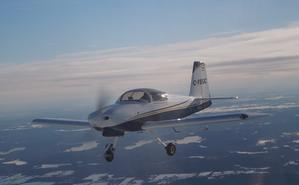
Photo copyright Martin Leroux, 2013. All rights reserved.
